Clinton and the British Commonwealth Air Training Plan
Radar Training at Clinton
[A fictional letter based on archival materials from the Secrets of Radar Museum]
September 14, 1943
Dear Alice,
The strangest thing happened the other day. I nearly shot the station commander. As you know I’m stationed at the No. 5 Radio School near Clinton Ontario. I’m an MP so it’s my job to defend the base. This means that any unidentified persons approaching the base after curfew are considered potential saboteurs.
I was doing my job last Wednesday night, patrolling the east gate when I see someone approaching. I called out, “Identify yourself!” and they said nothing just kept walking. So I asked again. And nothing. Now I was getting a bit worried so, as we were ordered to do, I fired off a warning shot in the direction of this stranger. That got his attention.
The spotlights had swiveled to our area and now I could make out his face. I realize that it’s K.R. Patrick, the base commander himself, that I’d shot at. He yells out to me, still walking towards the gate mind, “What the devil are you doing you fool? You could have killed me!” Orders being orders, I yelled back, “For the third time, identify yourself!” At this point it dawned on him what was going on. He realized that he was the one in the wrong. He called out his name, rank and number. When he got to me, he showed me his ID.
Turns out he was so lost in thought that he didn’t hear me. The shot was as much of a shock to him as seeing him was a shock to me. Apparently, he was in town on some personal business and thought he would walk back. He got turned around in the woods and couldn’t find his way back before curfew.
Other than that little bit of excitement, I’m doing well. I hope the little ones are doing well in school and aren’t giving you too much trouble. And I really appreciate the cookies Marie sent. Tell her they were delicious. Also, let her know that the food has improved a lot since the RCAF took over from the Brits. Remind me when I next get leave to tell you and the family about the food fight I had to break up last year.
Your loving brother,
Peter
P.S. Don’t tell Mom! We both know she won’t find it funny. And I’ll just end up with a terse letter lecturing me to not accidentally almost shoot people.
P.P.S. Maybe one day they’ll tell me what I’m actually guarding. It’s strange working on an Air Force base that doesn’t even have a runway. But I guess there are enough of those in the area anyway.
Local British Commonwealth Air Training Plan Sites
In 1939, the British Commonwealth Air Training Plan (BCATP) agreement was signed between Great Britain, Canada, Australia, and New Zealand to train aircrew for service in other countries. In 1941, the United States entered BCATP. The Plan trained aircrew, like pilots, navigators, bomb aimers, wireless operators and flight engineers.
BCATP planned to train more than 131,000 Canadian and Allied aircrew during the Second World War. Within months the government built airfields, schools, and other training institutions from scratch. Other places were renovated and put to new use. Many people created businesses to support the government’s war effort. Every province helped.
The BCATP created almost 200 new institutions in almost 150 communities across the country. There were 11 bases and relief fields around London. These included:
- Aylmer: No. 14 Service Flying Training School (which subsequently moved to Kingston) and No. 1 Flight Engineers School
- Centralia: No. 9 Service Flying Training School
- Clinton: No. 31 Radio Direction Finding (RADAR) School
- Fingal: No. 4 Bombing and Gunnery School
- Goderich: No. 12 Elementary Flying Training School
- London: No. 3 Elementary Flying Training School and No. 4 Air Observer School
- St. Thomas: No. 1 Technical Training School
By the end of the war, the BCATP had successfully trained over 131,000 military personnel from the British Commonwealth and allied nations. The BCATP was one of Canada’s largest contributions to the Second World War, and the effects of the program remained prevalent in these communities for generations. Many participants of the program settled in these communities, and many women married men they met during this program.



